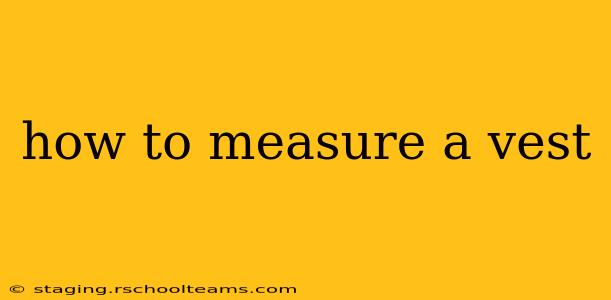Finding the perfect-fitting vest can be tricky, but accurate measurements are key to ensuring a comfortable and stylish look. Whether you're buying a ready-to-wear vest or having one custom-made, understanding how to measure yourself correctly is crucial. This guide will walk you through the essential measurements needed for a proper fit. We'll cover everything from chest and waist measurements to shoulder width and length, answering frequently asked questions along the way.
What Measurements Do I Need to Take for a Vest?
To accurately measure for a vest, you'll need to take several key measurements. These include:
- Chest: This is the most crucial measurement. It's taken around the fullest part of your chest, keeping the measuring tape parallel to the floor.
- Waist: Measure around your natural waistline, the narrowest part of your torso.
- Shoulder Width: This is measured across your back, from one shoulder bone to the other.
- Vest Length: This measurement is taken from the base of your neck (where your collarbone meets your neck) down to the desired length of your vest. This can vary depending on the style of vest.
- Back Width: This is measured across the back at the widest point, usually just below the shoulder blades. This measurement helps ensure a proper fit across the shoulders and back.
How to Take Accurate Vest Measurements
Here's a step-by-step guide to taking each measurement:
-
Chest: Wrap the measuring tape around your chest at its fullest point, ensuring it's level and comfortable but not too tight. Record the measurement.
-
Waist: Locate your natural waistline – the narrowest part of your torso, usually above your belly button. Wrap the measuring tape around your waist at this point, ensuring it's comfortable but not restrictive. Note the measurement.
-
Shoulder Width: Stand with your back straight and shoulders relaxed. Place the measuring tape at the edge of one shoulder bone and extend it across your back to the edge of the other shoulder bone. Record the measurement.
-
Vest Length: Determine your desired vest length. Stand straight and measure from the base of your neck (where your collarbone meets your neck) down to the desired length. This could be to your waist, hip, or even longer. Record the measurement.
-
Back Width: Find the widest part of your back, usually just below your shoulder blades. Measure across your back at this point, ensuring the measuring tape is level. Record the measurement.
What if I Don't Have a Measuring Tape?
While a flexible measuring tape is ideal, you can use a piece of string or ribbon. Wrap it around the relevant area, mark the point where it overlaps, and then measure the string/ribbon against a ruler.
What's the Difference Between Measuring for a Ready-to-Wear Vest and a Custom-Made Vest?
When buying a ready-to-wear vest, your measurements will help you choose the appropriate size from the brand's size chart. However, for custom-made vests, the tailor will use your measurements to create a garment tailored specifically to your body. More detailed measurements may be required for a truly bespoke fit.
How Important is it to Get the Measurements Exactly Right?
Accurate measurements are extremely important, especially for a custom-made vest. Even slight variations can affect the fit and overall look of the vest. If you're unsure, it's always best to err on the side of caution and get a second opinion.
Are there any other measurements I should consider?
While the measurements above are crucial, you might also consider measuring your armholes (circumference at the armhole) if you're ordering a custom vest or a very fitted style. This ensures proper sleeve or armhole fit.
By following these steps and taking accurate measurements, you can confidently purchase or commission a vest that fits perfectly. Remember to always double-check your measurements to ensure accuracy!
